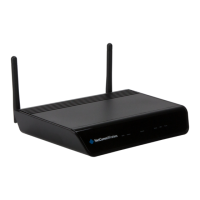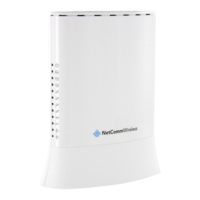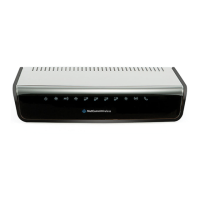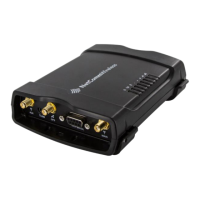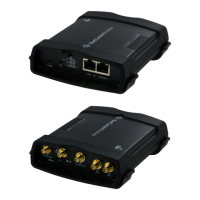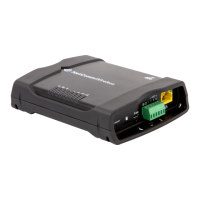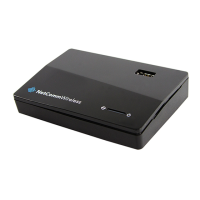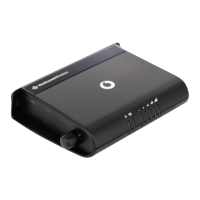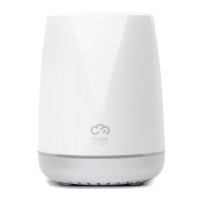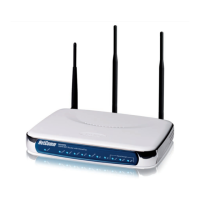Do you have a question about the NetComm NF13ACV and is the answer not in the manual?
| Device Type | Wireless Router |
|---|---|
| Wireless Standard | 802.11ac |
| Wireless Frequency Bands | 2.4 GHz and 5 GHz |
| USB Ports | 1 x USB 2.0 |
| ADSL/VDSL Compatibility | Yes |
| VPN Support | Yes |
| Ethernet Ports | 4 x 10/100/1000 Mbps |
| Security Protocols | WPA/WPA2 |
| Wireless Speed | Up to 1200Mbps |
Defines intended audience, prerequisites, and the purpose of the user guide.
Details the router's capabilities, technical specifications, and included items.
Precautions for safe product use, maintenance, and transportation.
Details the router's physical size and general LED indicator functions.
Explains the specific meaning and state of each router LED.
Details the physical ports on the router and their respective purposes.
Step-by-step guide for connecting the router to power and the network.
Methods to connect devices and configure the WAN internet connection.
Configuring wireless network names (SSID) and security settings.
Securing access to the router's web interface by setting credentials.
Steps to log in to the router's management console for advanced settings.
Overview of the router's current system, WAN, and wireless connection statuses.
Detailed explanations for each item displayed on the status page.
Configuring Ethernet and Mobile Broadband Wide Area Network connections.
Details for setting up PPP over Ethernet and other IP connection methods.
Configuration steps for a 3G/4G USB dongle internet connection.
Confirming the mobile broadband connection is active and displaying its details.
Setting the router's LAN IP address and configuring the DHCP server.
Customizing DHCP behavior and reserving specific IP addresses for devices.
Setting up the WiFi access point, SSID, security, and network mode.
Connecting wireless devices securely using Push Button Connect or PIN code methods.
Extending WiFi coverage using WDS and viewing connected wireless clients.
Configuring the router's firewall and Network Address Translation (NAT) port forwarding.
Setting up port triggering for applications and configuring a DMZ host.
Implementing packet filtering for inbound/outbound traffic and DMZ host setup.
Setting up rules to allow or deny network access based on MAC addresses.
Configuring rules to block access to specified domain names.
Understanding and setting up manual network routes for packet forwarding.
Procedures for adding new static routes and removing existing ones.
Enabling and configuring RIP for advertising routes to other routers.
Configuring rules to block access to specific websites based on URL keywords.
Configuring IPSec tunnels for secure site-to-site or remote access VPNs.
Configuring advanced IPSec tunnel settings like encryption and authentication.
Configuring the router to establish L2TP VPN client connections.
Configuring the router to function as an L2TP VPN server.
Configuring the router to establish PPTP VPN client connections.
Configuring the router to function as a PPTP VPN server.
Manually setting LAN and WAN port speeds and duplex modes.
Enabling Universal Plug n Play for automatic device detection on the network.
Setting up Dynamic DNS services to update name servers with the current IP address.
Configuring traffic management to prioritize specific types of network traffic.
Configuring SNMP for remote network monitoring and management.
Synchronizing the router's internal clock with Internet Time servers.
Setting up schedules for functions like packet filtering, WiFi, QoS, and LED brightness.
Steps to create specific schedule policies, days, and time ranges.
Configuring IPv6 features, connection types, and IP addresses.
Configuring the TR-069 client for automatic remote configuration.
Inputting service domain details provided by the VoIP service provider.
Configuring SIP/RTP ports and selecting audio codecs for VoIP calls.
Selecting the DTMF standard to use for VoIP service interactions.
Configuring STUN server for NAT traversal and FXS phone port operation.
Adjusting dial plan and other miscellaneous VoIP settings.
Setting up call forwarding options and enabling Do Not Disturb mode.
Configuring caller ID display, flash time detection, and call waiting.
Setting up automatic hotline dialing and feature activation key combinations.
Storing and dialing phone numbers from the phone book for easy access.
Accessing, viewing, and configuring system event logs and remote syslog.
Changing administrator passwords and configuring general system administration options.
Configuring remote access, adjusting LED brightness, and performing diagnostic ping tests.
Saving current router settings to a file and restoring them later.
Procedures for upgrading the router's firmware and running the startup wizard.
Steps to perform a soft reboot of the router to implement configuration changes.
An index listing all tables present within the user manual.
Lists default IP address, subnet mask, username, and password.
Procedures for resetting the router to its original factory settings.
Information regarding ACMA requirements and Australian/New Zealand consumer protection laws.
Details product warranty conditions and the company's legal liability limitations.
Provides the address, phone, fax, and email for NetComm Wireless support.
